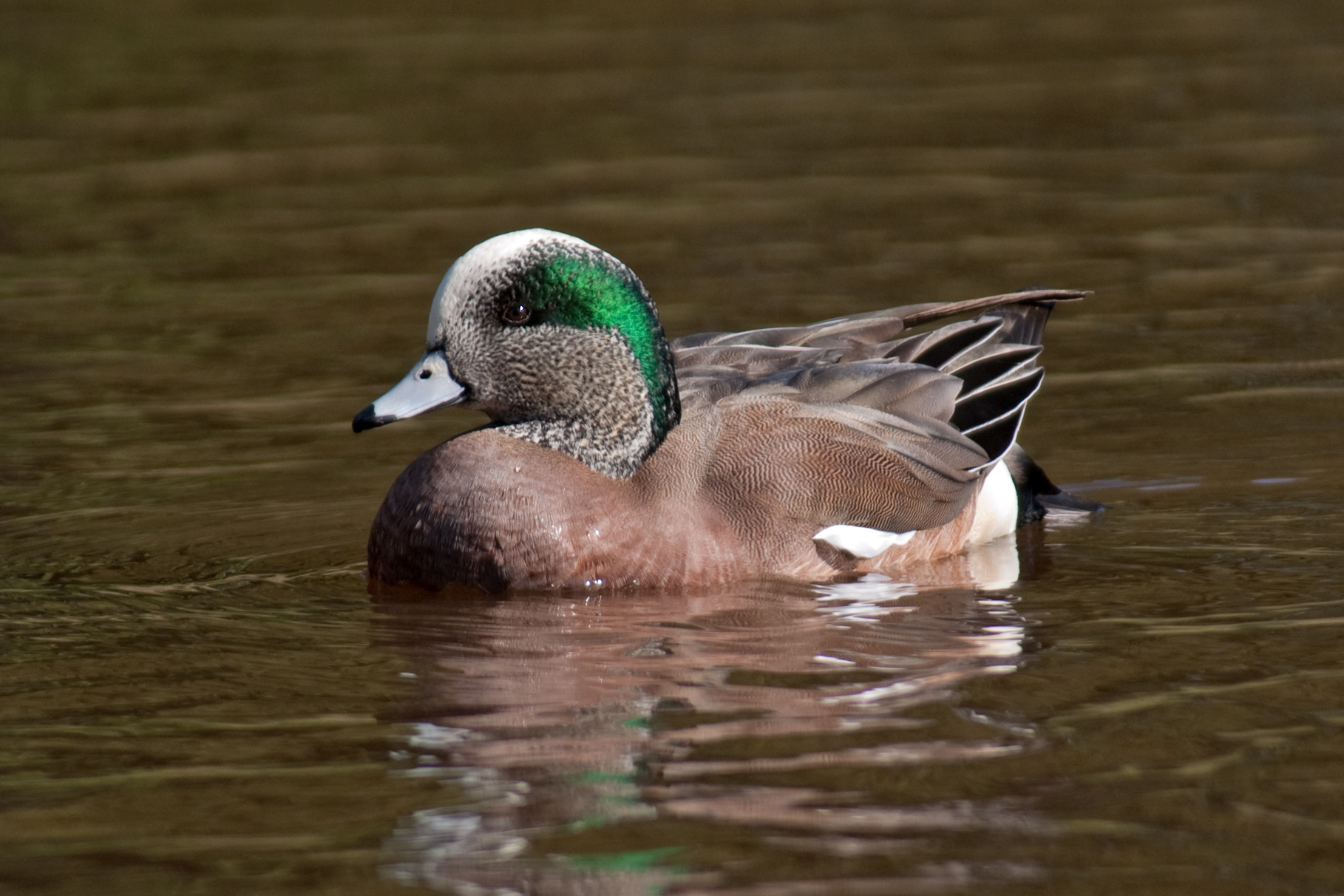American Wigeon (male)—Photo: Dow Lambert
Tribute to the American Wigeon
November 2021
by Bob Boekelheide
This month we give tribute to the humble American Wigeon, typically the most abundant species on the Sequim-Dungeness Christmas Bird Count (SDCBC, coming up on Dec. 20, 2021). For 37 of the 45 SDCBCs since the count started in 1975, American Wigeon has outnumbered all other species. This is no small feat, considering that wigeons compete for high count with species such as Mallard, Dunlin, and Glaucous-winged Gull, all abundant powerhouses in their own right.
American Wigeon (male) - Photo: Dow Lambert
Here is a graph (Figure 1) showing the number of American Wigeons observed on the SDCBC over the last 25 years.
Several interesting things pop out from the graph:
1. It appears that wigeons may have increased on the SDCBC over the last 25 years, since the slope of the regression line is positive.
2. The number of wigeons varies a lot between years. This was particularly true between 2009 and 2012, when the count ranged between its highest count (16,929 in 2009) and lowest count (4,994 in 2012) within just three years.
3. Because of this variability, the points on the graph don't fit the regression line very well, as indicated by its fairly low coefficient of determination (R2) of 0.34. Remember your basic statistics -- the coefficient of determination approaches 1.0 when a set of points closely fits its regression line, whereas the coefficient of determination approaches 0.0 if the set of points is random and doesn't fit its regression line very well.
Could wigeons in our area possibly vary that much from year to year? Maybe, maybe not. Anyone who has tried to count wigeons on our CBC knows that they are not easy to count. They often occur in large flocks of hundreds or thousands of birds, which requires close attention and much patience to get accurate estimates. We often partition the flocks into smaller groups, counting them by tens or hundreds, to estimate total flock sizes. Stormy, windy weather on CBC day makes it even less likely that we get accurate numbers.
Hunting season may also disperse wigeons, so active hunters on CBC days (and hunting Bald Eagles, too) often cause flocks to take flight and move around. This could lead to multiple CBC parties counting the same group of wigeons, particularly in Dungeness Bay. Conversely, hunting also causes the birds to gather into tighter flocks, which might actually make them easier to estimate. It is my job as CBC compiler to sort out the discrepancies and determine where overlapping counts might occur.
Lastly, weather has a huge influence on wigeon distribution during the SDCBC, particularly freezing weather. If it is below freezing for a few days before our count, freshwater ponds in our area may be frozen solid. All the wigeons consequently gather on saltwater, particularly Dungeness Bay, where we can estimate the large flocks. Conversely, when temperatures stay above freezing and freshwater ponds are open, wigeons scatter all over the Sequim-Dungeness Valley. We do our very best to count the most important ponds, but we certainly do not get to every pond to count every single wigeon.
Anyone walking in winter at Carrie Blake Park in Sequim might witness this. When daytime temperatures consistently stay above freezing, a couple thousand wigeons sometimes hang out in the park, grazing on the playing field and escaping to nearby ponds when chased by dogs or when eagles fly over. In contrast, when we have really cold weather and the Carrie Blake Ponds ponds are frozen over, relatively few wigeons remain in the park.
Regardless, American Wigeons averaged about 10,000 birds per SDCBC during the last 25 years. I suspect this number is a fairly good ballpark figure for the number of wigeons found in the Sequim-Dungeness Valley in mid-December.
What is the annual cycle of American Wigeons in our area? To answer this question, we go to another OPAS community-science project. Between 2014 and 2018, OPAS volunteers assisted North Olympic Salmon Coalition and WA Dept of Fish and Wildlife by counting birds during the Three Crabs Nearshore Habitat Restoration Project, to see if the project changed bird use in the Three Crabs Area. One of the survey areas was Three Crabs Beach, where we counted birds within a defined area during every ten-day period between 2014 to 2018.
The next graph (Figure 2) shows the annual cycle of wigeons within our Three Crabs Beach study area, as shown by the average monthly high counts. The highest number of wigeon at Three Crabs occurred during fall migration, peaking at several thousand in October. Their numbers steadily declined through winter and spring, then dwindled to almost zero during the nesting season in June and July, when wigeons go north to breed.
Mind you, this graph only shows our wigeon counts in a small section of nearshore Dungeness Bay. There are many more wigeons elsewhere in the Sequim-Dungeness Valley not included in this graph. Wigeons may graze in fields and parks somewhere during the day, then roost together in marshes or offshore during the night. After hunting season starts in mid-October, lots of wigeon go somewhere other than Three Crabs. They might stay offshore in other sections of Dungeness Bay, they might go inland to freshwater ponds, or they might even migrate somewhere else for the winter.
Where else do they go in winter? The highest numbers on Washington CBCs often occur at Padilla Bay, sometimes double or triple the numbers we count at Sequim-Dungeness. Even Padilla Bay numbers don't compare, however, with wigeon numbers further south, particularly in the Sacramento Valley in Northern California. The highest winter counts in the Pacific Flyway occur at refuges and wildlife areas around the Sutter Buttes, like Delevan, Colusa, Sutter, Sacramento, Butte Sink, and Graylodge, where they sometimes tally more than a quarter million wigeon. Of interest, peak wigeon counts by the USFWS in the Sacramento Valley typically occur in November, whereas our peak counts occur in October. This suggests that some birds may use Washington as a migration stopover before eventually flying further south to spend the winter.
Fall and winter is the time when wigeons pair up for the next nesting season. Apparently population sex ratios are skewed to more males than females, so competition between males for female mates can be intense. Pairs stay together through the winter, so by the time they migrate north in spring the mates travel together to the nesting area of the female's choosing.
Flying American Wigeon - Photo: Dow Lambert
Where do all these wigeons go in the nesting season? According to Birds of the World (the wonderful online resource from Cornell Lab of Ornithology), most American Wigeons nest in western Canada and Alaska. Some nest on the tundra, some nest in taiga forests, and some nest in prairie grasslands. The common denominator is that female wigeons place their nests in brushy and grassy areas near freshwater ponds and wetlands, where they eventually take their chicks after they hatch.
On average, wigeon females lay about 7 to 10 eggs in each clutch. The eggs' incubation takes about 25 to 28 days, all done by the female. The male stays near the female for a few days after she lays eggs, then he takes off to molting areas sometimes hundreds of miles away. Chicks leave the nest within 24 hours of hatching, waddling to water with their mother. If they survive, chicks begin flying about 6 to 7 weeks after hatching. Less than half of clutches typically result in fledged young, as most of the chicks are lost to predation and exposure each year.
Many female wigeons apparently nest when they are only one year old, but most males do not nest until their second year. According to banding studies, survival rates of adult wigeons are not great, as only about one-half to two-thirds of adults survive to nest again each year. The average adult wigeon probably only lives about two to three years, even though the oldest banded American Wigeon on record lived to 21 years old.
Like most dabbling ducks, wigeons are largely vegetarians, although females may eat higher amounts of insects, molluscs, and crustaceans before nesting. In Dungeness Bay, their diet appears to be mostly eelgrass and green algae, particularly Ulva, which grows in abundance on the mudflats and washes ashore in huge windrows during late summer and fall. In upland habitats, wigeons graze on grasses, forbs, and aquatic plants. There is even an aquatic plant called "widgeon-grass," also known as "ditch-grass," usually found in shallow fresh or brackish water.
A description of wigeons would not be complete without some mention of their distinctive call note, which is often likened to a squeeky bathtub toy. This call, known as the "slow whistle”, is largely made by males. It has three descending notes, sounding like "whee, whee, whee." Females have a quiet quack that they make to their mate when taking flight, also known as the "flying call."
It is easy to say "they're just wigeons" when birding around here during fall and winter, since there are so many wigeons out there. I ask you to slow down and take the time to watch these little ducks, appreciating their wily ways and perky postures. Also look through the big flocks for Eurasian Wigeons, the red-headed cousins of the Americans.
American Wigeon (male) and Eurasian Wigeon (male) - Photo Dow Lambert
Many of the interesting facts about wigeon contained in this story came from Birds of the World, an on-line resource available through Cornell Lab of Ornithology. I highly recommend that all bird aficionados subscribe to Birds of the World, both for the information and to support the Lab of Ornithology.


